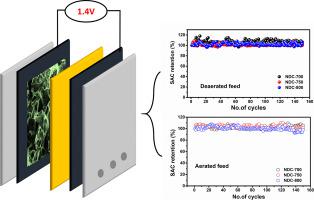Desalination ( IF 9.9 ) Pub Date : 2021-04-24 , DOI: 10.1016/j.desal.2021.115099 Manar M. Taha , Soha E. Anwar , Mohamed Ramadan , Hazem M. Al-Bulqini , Muhammed S. Abdallah , Nageh K. Allam

|
Capacitive deionization (CDI) is a feasible low-cost desalination technique for low-to-medium (brackish) salinity water. However, cycling stability and regeneration of the CDI electrodes are the bottlenecks hindering the practical application of the technology on large scale. Oxidation of the electrodes during the sequential adsorption-desorption processes is one of the most challenging problems hindering their long-term cycling performance. Herein, we demonstrated the ability to design and fabricate exceptionally stable CDI electrodes via a one-pot pyrolysis protocol. The optimized pyrolysis of nitrogen‑carbon precursors at different temperatures enabled the fabrication of carbon materials with a controlled amount nitrogen dopant (NDCs) with exceptional cycling stability. The NDCs showed high specific capacitance and dual meso/microporous structures with high salt adsorption capacity (SAC), reaching 26.5 mg·g−1 in a single-pass desalination mode. Moreover, all NDC electrodes exhibited exceptional desalination stability performance over 150 successive charging/discharging cycles with 100% retention in aerated and deaerated solutions under harsh 1.4 V as the charging voltage. Moreover, all NDCs cells demonstrated charge efficiencies in the range from ~40 to 60%. The potential of zero charge (PZC) was determined for the tested NDC electrodes to elucidate their oxidation resistance (EOR). The electrodes exhibited a minimal shift in potential after the entire desalination stability tests, revealing minor electrode oxidation. The performance of our NDC-electrodes was compared against that of the commercially available activated carbon (AC) under the same experimental conditions, with the latter showing a server decrease in the SAC retention within the first few cycles.
中文翻译:

受控制造介孔电极,具有前所未有的稳定性,可在恶劣条件下在大型电池中进行水电容去离子
电容去离子(CDI)是一种适用于中低盐度咸水的低成本脱盐技术。然而,CDI电极的循环稳定性和再生是阻碍该技术大规模实际应用的瓶颈。在顺序吸附-解吸过程中电极的氧化是阻碍其长期循环性能的最具挑战性的问题之一。在此,我们展示了设计和制造非常稳定的CDI电极的能力通过一锅热解方案。氮碳前驱体在不同温度下的优化热解,使得能够制造具有可控氮掺杂剂(NDC)且具有出色循环稳定性的碳材料。NDCs具有高的比电容和双介孔/微孔结构,并具有高的盐吸附能力(SAC),达到26.5 mg·g -1在单程脱盐模式下。此外,所有NDC电极在150个连续的充电/放电循环中均表现出卓越的脱盐稳定性能,在1.4 V的苛刻充电电压下,在充气和脱气溶液中100%保留。此外,所有NDCs电池均表现出约40%至60%的充电效率。确定了测试NDC电极的零电荷电势(PZC),以阐明其抗氧化性(EOR)。在整个脱盐稳定性测试后,电极的电势变化最小,显示出较小的电极氧化。在相同的实验条件下,我们将NDC电极的性能与市售活性炭(AC)的性能进行了比较,



























 京公网安备 11010802027423号
京公网安备 11010802027423号